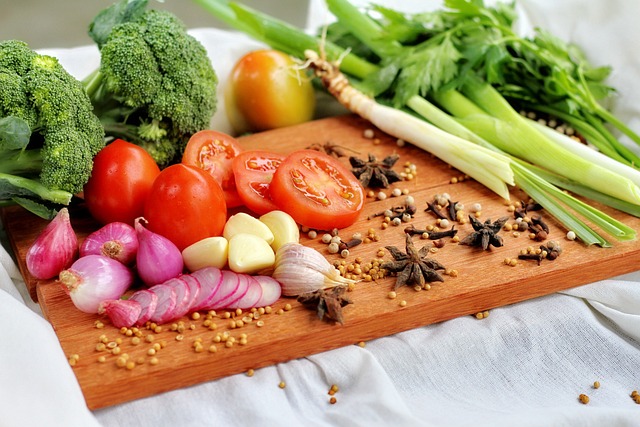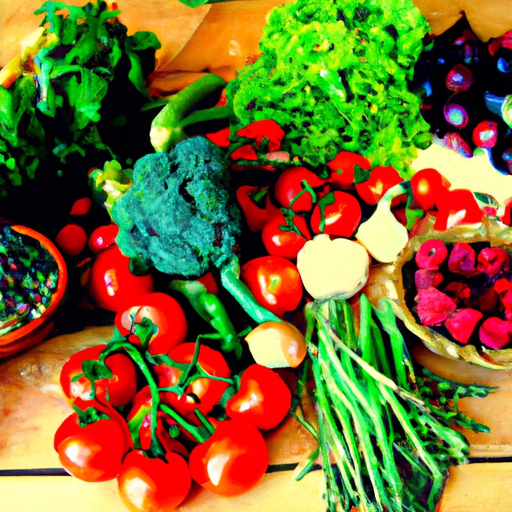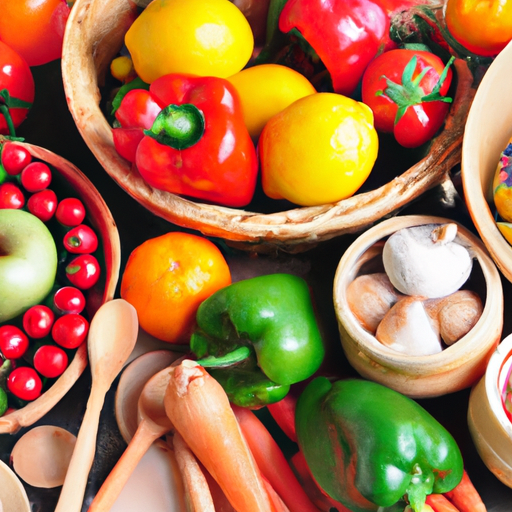Are you tired of eating the same old vegetarian meals every day? Feel like your diet is lacking in variety and excitement? Well, fear not! There are plenty of ways to make your vegetarian diet more varied and interesting. In this article, we will explore some simple yet delicious ways to spice up your vegetarian meals and keep your taste buds satisfied.
One of the easiest ways to add variety to your vegetarian diet is to experiment with different fruits and vegetables. Instead of sticking to the same old staples like broccoli and carrots, why not try exotic options like dragon fruit or jicama? By incorporating a wide range of colors, textures, and flavors into your meals, you can instantly make them more interesting.
Another way to make your vegetarian diet more varied is to try out different cooking techniques. Instead of always steaming or boiling your veggies, why not give them a go on the grill or in the oven? Roasting vegetables can bring out a whole new depth of flavor, while grilling can add a delicious smoky char.
Lastly, don’t be afraid to get creative with your vegetarian protein sources. While tofu and beans are great options, there are plenty of other alternatives out there. Have you ever tried tempeh or seitan? These protein-packed foods can add a unique twist to your meals and make them more interesting.
So, if you’re looking to break out of your vegetarian rut and add some excitement to your meals, give these tips a try. You’ll be amazed at how a little variety can go a long way in making your vegetarian diet more varied and interesting. Stay tuned for our next article, where we’ll dive even deeper into the world of vegetarian cuisine.
Introduction
Are you someone who follows a vegetarian diet and finds yourself craving more variety in your meals? Do you sometimes struggle to come up with creative ways to make your vegetarian dishes more interesting? If so, you’re not alone! Many people choose to adopt a vegetarian lifestyle for various reasons, such as health, ethical, or environmental concerns. However, it’s common to face challenges when trying to keep your meals diverse and exciting while avoiding meat and animal products. In this article, we’ll explore different ways to make your vegetarian diet more varied and interesting, from exploring different proteins to cooking techniques, and even growing your own vegetables. So let’s dive in and discover how you can spice up your vegetarian menu!
Exploring Different Vegetarian Proteins
Tofu and tempeh
Tofu and tempeh are versatile and nutritious protein options that can add variety to your vegetarian diet. Tofu comes in different textures, such as soft, firm, or extra firm, and can be used in stir-fries, soups, or marinated and grilled. Tempeh is made from fermented soybeans and has a chewy texture with a slightly nutty taste. It can be sliced and pan-fried, crumbled into dishes, or used as a meat substitute in burgers or sandwiches.
Legumes and beans
Legumes and beans are excellent sources of protein and fiber, and they come in a wide variety of options. From chickpeas and lentils to black beans and kidney beans, there’s no shortage of choices. Incorporate them into your meals by making homemade hummus, adding them to salads, or creating hearty stews and chili. You can also experiment with different cuisines that feature legumes, such as Indian dal or Mexican refried beans.
Quinoa and amaranth
Quinoa and amaranth are nutritious grains that are complete sources of protein, meaning they contain all the essential amino acids. They can be cooked and used as a base for salads, served as a side dish, or used as a stuffing for vegetables. Both quinoa and amaranth have a mild, nutty flavor that pairs well with various herbs, spices, and vegetables.
Seitan and textured vegetable protein (TVP)
Seitan, also known as wheat meat, is a meat substitute made from gluten. It has a chewy texture and can be used as a substitute for chicken or beef in recipes like stir-fries, sandwiches, or stews. Textured vegetable protein (TVP) is another meat substitute made from soy flour. It comes in small pieces that can be rehydrated and used in dishes like chili, tacos, or bolognese sauce.
Alternative meat substitutes
If you’re looking for meat substitutes that closely resemble the taste and texture of meat, there are many options available on the market. These include products made from soy, tempeh, seitan, and even vegetables like mushrooms and jackfruit. These meat substitutes can be used to make vegetarian burgers, sausages, meatballs, or even “pulled pork” sandwiches.

Incorporating a Rainbow of Fruits and Vegetables
Benefits of a diverse fruit and vegetable intake
Including a wide variety of fruits and vegetables in your vegetarian diet is not only important for your health but also for adding excitement to your meals. Each fruit and vegetable brings its unique combination of vitamins, minerals, and antioxidants, which can support your overall well-being. Different colors indicate different nutrients, so aim to incorporate a rainbow of fruits and vegetables into your meals.
Choosing seasonal produce
One way to ensure variety in your vegetarian diet is to choose seasonal produce. Not only does it taste better when it’s in season, but it also tends to be more affordable and readily available. Seasonal produce also adds a natural element of diversity to your meals as different fruits and vegetables come into season throughout the year.
Experimenting with different cooking methods
Another way to make your vegetarian meals more interesting is to experiment with different cooking methods. Roasting vegetables brings out their natural sweetness and adds a delicious caramelized flavor. Steaming helps retain nutrients and brings out the vibrant colors of vegetables. Grilling adds a smoky flavor, and sautéing provides a quick and easy way to cook your veggies while retaining their crispness.
Exploring exotic fruits and vegetables
Expand your palate and add variety to your vegetarian diet by exploring exotic fruits and vegetables. Dragon fruit, papaya, jicama, and jackfruit are just a few examples of unique produce that you may not have tried before. Exploring ethnic grocery stores or specialty markets can lead you to discover new and exciting ingredients that can transform your meals.
Including leafy greens and cruciferous vegetables
Leafy greens and cruciferous vegetables are packed with nutrients and can enhance the variety of your vegetarian meals. Spinach, kale, Swiss chard, broccoli, cauliflower, and Brussels sprouts are some examples of these nutrient-rich vegetables. They can be used in salads, stir-fries, soups, or even roasted as a side dish. Experimenting with different cooking techniques and seasonings can help you find the flavors and textures you enjoy the most.
Exploring Global Cuisines
Mediterranean cuisine
Mediterranean cuisine offers a wide array of vegetarian dishes that are both delicious and satisfying. From Greek salads to spanakopita (spinach and feta cheese pie) and falafel, this cuisine celebrates the flavors of fresh vegetables, olive oil, herbs, and spices. Try incorporating Mediterranean-inspired dishes into your vegetarian diet for a taste of the Mediterranean lifestyle.
Asian cuisine
Asian cuisine, including Chinese, Japanese, Thai, and Indian, offers a wealth of vegetarian options. From vegetable stir-fries and curries to sushi rolls and noodle dishes, there’s something for everyone. Asian cuisines often incorporate a variety of vegetables, tofu, and aromatic herbs and spices, creating flavorful and diverse meals that will keep your taste buds satisfied.
Mexican cuisine
Mexican cuisine is another great option for adding variety to your vegetarian diet. Beans, rice, corn, avocados, and tomatoes are staples in Mexican cooking and can be used to create delicious and hearty vegetarian dishes. Try making vegetarian enchiladas, tacos, or a colorful Mexican-style salad for a fiesta of flavors.
Indian cuisine
Indian cuisine is known for its flavorful vegetarian dishes, thanks to the rich variety of spices and herbs used. Dishes like chana masala (spiced chickpea curry), palak paneer (spinach and cottage cheese curry), and aloo gobi (potato and cauliflower stir-fry) are just a few examples of the vibrant vegetarian options available in Indian cuisine. Experimenting with Indian spices can add a new level of depth and complexity to your vegetarian meals.
African cuisine
African cuisine encompasses a diverse range of flavors and ingredients from different regions of the continent. Dishes like Moroccan tagines, Ethiopian injera bread with lentil stew, and West African peanut soup offer exciting vegetarian options. Explore the rich and bold flavors of African cuisine to bring something new and unique to your vegetarian menu.

Creative Cooking Techniques
Grilling and roasting
Grilling and roasting are cooking techniques that can bring out the natural flavors and textures of vegetables. Grilled vegetables like bell peppers, zucchini, and eggplant can be used as toppings for sandwiches or tossed into salads. Roasted vegetables like carrots, sweet potatoes, and Brussels sprouts become caramelized and crispy, offering a contrast in flavors and textures.
Stir-frying and sautéing
Stir-frying and sautéing are quick and easy methods for cooking vegetables while maintaining their color and crunch. Heat up a wok or skillet, add a splash of oil, and toss in your favorite vegetables with some garlic, ginger, or soy sauce. These cooking techniques allow you to create vibrant and flavorful dishes in no time.
Baking and broiling
Baking and broiling are techniques that can transform vegetables into a whole new culinary experience. Roasted cauliflower florets can become crispy and golden brown when baked, while broiled tomatoes can intensify their sweetness and juiciness. These methods open up a realm of possibilities for adding depth and flavor to your vegetarian dishes.
Marinating and pickling
Marinating and pickling are techniques that can infuse vegetables with bold and tangy flavors. Marinate tofu in a mixture of soy sauce, ginger, and garlic for a savory and umami-rich protein option. Pickle cucumbers, carrots, or radishes in a vinegar brine for crisp and tangy additions to salads and sandwiches. These techniques add complexity and intrigue to your vegetarian meals.
Blending and pureeing
Blending and pureeing vegetables can create creamy and smooth textures, perfect for soups, sauces, and dips. Blend roasted red peppers, tomatoes, and garlic for a flavorful and velvety soup. Puree cooked cauliflower for a creamy and nutritious alternative to mashed potatoes. These techniques allow you to explore different consistencies and flavors in the world of vegetarian cooking.
Experimenting with Herbs and Spices
Flavor profiles of different herbs and spices
Herbs and spices play a crucial role in adding depth and complexity to vegetarian dishes. Each herb and spice has its unique flavor profile. For example, basil adds a fresh and slightly sweet taste, while cumin offers an earthy and warm flavor. Understanding the characteristics of different herbs and spices can help you create well-balanced and flavorful vegetarian meals.
Trying new combinations
Don’t be afraid to experiment with different herb and spice combinations. Mixing herbs and spices that complement each other can elevate the flavors of your vegetarian dishes. For example, combining thyme, rosemary, and garlic can create a savory Mediterranean flavor profile, while a blend of turmeric, coriander, and ginger can provide a bold and aromatic Indian-inspired taste.
Using herbs and spices in marinades and dressings
Marinades and dressings are a great way to incorporate herbs and spices into your vegetarian cooking. Create a tangy marinade by combining lemon juice, olive oil, garlic, and herbs like oregano or dill. Whip up a creamy salad dressing with herbs like basil or cilantro, and spices like paprika or cumin. These flavor-packed sauces can bring out the best in your vegetarian dishes.
Exploring ethnic spice blends
Different cuisines around the world have their signature spice blends that can add a unique twist to your vegetarian meals. Moroccan ras el hanout, Indian garam masala, and Chinese five-spice powder are just a few examples of these flavor-packed combinations. Experimenting with these blends can take your vegetarian dishes on a cultural journey and introduce new and exciting flavors.

Vegetarian Meal Planning Ideas
Weekly meal prep
Planning and preparing your meals in advance can help ensure a varied and interesting vegetarian diet. Set aside time each week to plan your meals, make a grocery list, and do some prepping. Cook large batches of grains, beans, or roasted vegetables that can be used as a base for multiple meals throughout the week. Having these components ready to go will make it easier to create diverse and well-balanced vegetarian meals.
Batch cooking
Consider batch cooking when you have the time and energy to prepare larger quantities of food. Cooking in bulk allows you to have ready-made meals that you can freeze or refrigerate for later use. This can be especially helpful for those busy days when you don’t have time to cook from scratch. Batch cooking also offers the opportunity to experiment with new recipes and ingredients, making your vegetarian meals more varied and interesting.
Building balanced meals
Aim to create balanced meals that include a variety of food groups to ensure you’re getting all the necessary nutrients. Include a source of protein such as tofu, legumes, or vegetarian meat substitutes, along with whole grains like quinoa or brown rice. Add a generous portion of vegetables, whether raw, steamed, or roasted, to amp up the nutritional value and flavors. Don’t forget to include healthy fats like avocado, nuts, or olive oil for added satiety and flavor.
Including a variety of textures and flavors
Variety in textures and flavors can make your vegetarian meals more interesting. Combine crunchy vegetables with creamy sauces or dressings, or add roasted nuts or seeds for a satisfying crunch. Experiment with different cooking techniques and ingredient pairings to create a diverse range of tastes and textures that will keep your meals exciting.
Growing Your Own Vegetables and Herbs
Benefits of homegrown produce
Growing your own vegetables and herbs can enhance the variety in your vegetarian diet while providing you with a sense of fulfillment and accomplishment. Homegrown produce is fresh, nutritious, and free of pesticides or preservatives. You can experiment with different varieties of vegetables and herbs that may not be readily available in grocery stores, adding unique flavors and textures to your meals.
Simple vegetable and herb gardening tips
Starting a vegetable and herb garden doesn’t have to be complicated or require a large outdoor space. Even a small balcony or windowsill can accommodate potted herbs or container vegetables. Start by researching the specific growing requirements of the vegetables and herbs you want to cultivate. Many herbs, such as basil, parsley, and mint, are relatively easy to grow and can thrive in containers. Vegetables like cherry tomatoes, peppers, or lettuce can also be grown in pots or raised beds.
Container gardening for limited spaces
Container gardening is a great option for those with limited outdoor space or no yard at all. You can use pots, planters, or even recycled containers to grow vegetables and herbs. Ensure your containers have drainage holes and use a good quality potting mix. Opt for compact or dwarf varieties of vegetables that are suitable for container gardening, such as cherry tomatoes, mini peppers, or bush beans.
Harvesting and preserving your own herbs
One of the joys of growing your own herbs is being able to harvest them fresh whenever you need them. Snip off sprigs of herbs like basil, rosemary, or thyme as you cook to add that extra burst of flavor. You can also dry or freeze excess herbs to extend their shelf life. Hang them upside down in a cool, well-ventilated area to air dry, or freeze them in ice cube trays with a little water or oil for convenient use later on.

Exploring Vegetarian Cookbooks and Online Resources
Cookbook recommendations
Vegetarian cookbooks are a treasure trove of recipes and culinary inspiration. Look for cookbooks by renowned vegetarian chefs or authors that focus on diverse and flavorful vegetarian dishes. Some popular vegetarian cookbooks include “Plenty” by Yotam Ottolenghi, “The Oh She Glows Cookbook” by Angela Liddon, and “Vegetarian India” by Madhur Jaffrey.
Online recipe websites and blogs
The internet offers a vast array of vegetarian recipe websites and blogs where you can find an abundance of ideas and inspiration. Websites like Minimalist Baker, Cookie and Kate, and Oh My Veggies provide delicious and creative vegetarian recipes that cater to different dietary preferences and cuisines. Explore these resources to find new and exciting recipes to incorporate into your vegetarian diet.
Joining vegetarian cooking communities
Connecting with like-minded individuals who share your passion for vegetarian cooking can be a great source of inspiration and support. Join online vegetarian cooking communities or forums where you can exchange recipes, tips, and ideas with others. Engaging in discussions and sharing your experiences can help you discover new techniques, ingredients, and perspectives on vegetarian cuisine.
Following vegetarian influencers
Follow vegetarian influencers on social media platforms like Instagram or YouTube to stay up to date with the latest trends and ideas in vegetarian cooking. Influencers often share their favorite recipes, cooking tips, and insights into their vegetarian lifestyle. Their posts and videos can serve as a source of motivation and encouragement as you continue to explore the world of vegetarian cuisine.
Conclusion
Incorporating variety, diversity, and excitement into your vegetarian diet can be a delightful journey of exploration and experimentation. By exploring different proteins, incorporating a rainbow of fruits and vegetables, exploring global cuisines, experimenting with cooking techniques, herbs and spices, meal planning, growing your own produce, and utilizing cookbooks and online resources, you can make your vegetarian diet more varied and interesting. Embrace the opportunity to try new flavors, techniques, and ingredients, and never stop learning and seeking inspiration. With countless possibilities at your fingertips, your vegetarian meals can truly be a celebration of flavors, textures, and creativity. So go ahead and embark on a culinary adventure that will keep your taste buds satisfied and your vegetarian diet full of excitement and variety!

